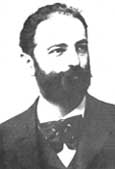Sigmund Freud And... |
Wilhelm Fliess
|
Strong friendship bonds are soon established between the two. Fliess is Freud's confessor and moral supporter, during Freud's most productive activity as a psychoanalyst and they exchange letters.
Fliess nevertheless was more than a mere audience and criticist of Freud's ideas - he himself had ambitious scientific contributions that asked for Freud's confirmation. Fliess is the author of a theory on the reflex nasal neuroses, including bisexuality and the theory of vital periodicity. This latter theory - a kind of biorhythmology - stated that all vital processes (pathological ones included) are developed in a cycle lasting 28 days in women, and 23 days in men. Various numerical relationships should have been helpful in determining the time for recovery after some disease, for instance and, why not, the likely date for someone's death.
Fliess' direct influences upon the birth of psychoanalysis are generally considered unimportant. Nevertheless, Fliess was the
first to draw Freud's attention on the significance of jokes as useful material for psychoanalytical research - Freud even used to declare: "It was you who have taught me that there
lies something true behind every popular fantasy" (1896). In addition, the earlier mentioned theory of bisexuality held a place of its own in the Freud's essays on sexuality published
at the beginning of the 1900's. Moreover, arithmetic calculus in the chapter on superstition included in the Psychopathology of Everyday Life, and other such maze-like associations
undoubtedly remind one biorhythmic calculus initiated by Fliess. The experience involving Fliess is more than the story of the projection of psychic ambivalence of an instance of
Freud, discovering an unquenchable need in himself of having a friend and an enemy, in the same person. Freud gained a lot from the confrontation of scientific ideas, including part of his
friend's conceptions into his nascent theories. We have become acquainted with professional and friendly relationships between Freud and Fliess from their letters as
preserved by Marie Bonaparte, in 1938, at a time when Freud was in great hurry to immigrate to Great Britain together with his family. Their correspondence covers the period between
1887-1902 and remains a first hand document for the study of the development of Freudian psychoanalytical thinking.
-- --
Article by Jean Chiriac
Translation by Mihaela Cristea
See also: Letter of Freud to Fliess - The Discovery of Oedipian Complex (October 15, 1897)
Read also:
|
|
Home | Resources | Forum | Newsletter | Contact Copyright 1999-2024, AROPA. All rights reserved.
![]()
